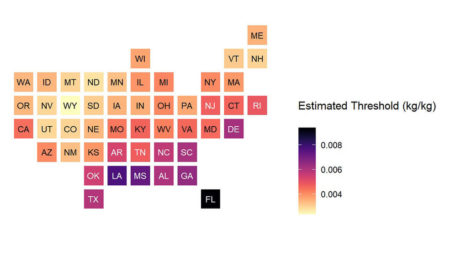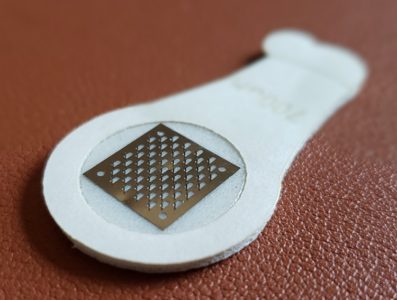Humidity and the flu, disgust and the shopping cart, Covid and the gentlemen, and more
08 Mar 2022
Posted by Andrew Kantor
Even the wrong flu vax works
Each year’s U.S. flu vaccines are based on the strain that appears in Australia during our summer — it’s our best guess at what strain will appear here. Usually it’s a partial match, which gives reporters something to write about: “Flu vaccine only 60% effective!”
But we’ve learned from Covid-19 that effective against disease and effective against severe illness are two different things.
So CDC wondered about the “wrong” flu vaccine. It turns out, they found (based on the awful 2019-20 flu season) that even a “mismatched” vaccine can cut a kid’s risk of hospitalization by almost half.
Vaccination was estimated to reduce the risk of critical influenza in children by 78% against [matched strains] and 47% against mismatched viruses. (Emphasis ours.)
Flumidity?
When will flu hit? It’s all about the humidity, says NASA, and it varies by state. When the humidity gets below a certain point each year, two weeks later the flu breaks out. For Georgia, that’s about 7g/kg.
That’s an absolute humidity. Based on this calculator, if it’s 50°F outside (10°C), Georgia crosses into flu season when (tap tap tap) … when the relative humidity drops below about 90 percent.

When it comes to chemo, women are different
People undergoing chemotherapy often have side effects — some severe. But women are much more likely to have them, especially with immunotherapy. What’s up with that?
One big problem (found a group of cancer researchers from across the country —with one Canadian for good luck) is that testing and development of treatments are all based on men and male cells.
That results in dosages that are “very well-tolerated” … for men. Women, though, metabolize drugs more slowly, and they’re also more prone to autoimmune diseases. But a physician consulting a chart for maximum tolerated dose isn’t taking into account a patient’s gender.
Result:
Overall, women were 34% more likely than men to experience severe adverse effects in response to their cancer treatments, a figure that increased to 49% for women receiving immunotherapies, according to a recent study in the Journal of Clinical Oncology.
Covid numbers
Cases, hospitalizations, deaths — all dropping, dropping, dropping.
- Only about 1,100 Georgians a day are testing positive now.
- Only 2,600 Covid cases are in the hospitals.
- Only about 64 Georgians a day are dying from Covid.
Worldwide, a minimum of 60 million people have died from Covid-19. (The reality is probably a lot higher, because of lack of testing.)
Good news, guys
Sure, The latest studies out of Canada and China show that Covid can do a lot of damage to the male reproductive system — causing erectile dysfunction, testicular pain and atrophy (!), lower testosterone, Peyronie’s* disease, and more.
The good news: They also found that “the effects may be transient” — decreased male fertility, for example, lasts only a few months — “and may be at least partially mitigated by vaccination.”
* Do. Not. Google.
Azithromycin, kids, and asthma
Keep this in the back of your mind: If you’ve got kids with bad asthma as patients, and they’re having trouble keeping it under control, azithromycin is your huckleberry.
A study out of India found that adding a bit of azithromycin (10 mg/kg, three times a week) to the therapy of 5 to 15 year-olds significantly improved control of their asthma, and cut their ER visits and steroid use.
The more you know.
Peanut needles
If you have a mouse with a peanut allergy, you might have heard of some big advancements lately that might reduce those allergies by using early, mild exposure.
Right now, the only way to do that is a strict oral therapy — pills. Up and coming are skin patches, which are worn 24 hours a day for two months. But University of Michigan allergy researchers think they’ve found a better delivery system: microneedles.
By delivering the allergen to the skin, a microneedle, um, device “significantly improve[s] desensitization” — better yet, it only has to be worn a few minutes a day for several weeks, and the dosage can be tweaked for the patient.

Walk this much
Older folks! If you’ve been doing your 10,000 steps a day, good news: You don’t have to!
A study meta-analysis out of UMass Amherst found that you really only need to do 6,000 to 8,000 — after that, the benefit levels off. That gives you time to hurry home and get those whippersnappers off your lawn.
(Young folks, keep walking. Your benefits level off at 8,000 to 10,000 steps.)
Weird Science: Shopping Cart edition
The horizontal handle of most shopping carts causes you to use your triceps. And using your triceps has a strange psychological effect: Because we use them when pushing something away from us, “triceps activation is associated with rejecting things we don’t like.”
Ergo, using a shopping cart is, subconsciously, a negative experience. And British scientists proved it. Shoppers who used a specially designed shopping cart with parallel handles (see below) “bought more products and spent 25 per cent more money than those using the standard trolley.”



